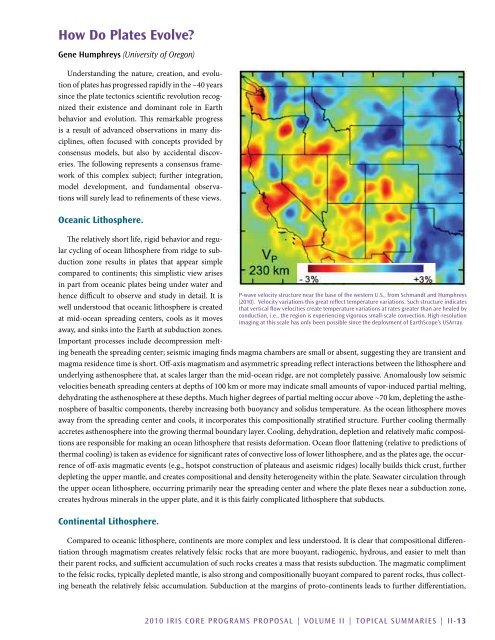Download Volume II Accomplisments (28 Mb pdf). - IRIS
Download Volume II Accomplisments (28 Mb pdf). - IRIS
Download Volume II Accomplisments (28 Mb pdf). - IRIS
Create successful ePaper yourself
Turn your PDF publications into a flip-book with our unique Google optimized e-Paper software.
How Do Plates Evolve?<br />
Gene Humphreys (University of Oregon)<br />
Understanding the nature, creation, and evolution<br />
of plates has progressed rapidly in the ~40 years<br />
since the plate tectonics scientific revolution recognized<br />
their existence and dominant role in Earth<br />
behavior and evolution. This remarkable progress<br />
is a result of advanced observations in many disciplines,<br />
often focused with concepts provided by<br />
consensus models, but also by accidental discoveries.<br />
The following represents a consensus framework<br />
of this complex subject; further integration,<br />
model development, and fundamental observations<br />
will surely lead to refinements of these views.<br />
Oceanic Lithosphere.<br />
The relatively short life, rigid behavior and regular<br />
cycling of ocean lithosphere from ridge to subduction<br />
zone results in plates that appear simple<br />
compared to continents; this simplistic view arises<br />
in part from oceanic plates being under water and<br />
hence difficult to observe and study in detail. It is<br />
well understood that oceanic lithosphere is created<br />
at mid-ocean spreading centers, cools as it moves<br />
away, and sinks into the Earth at subduction zones.<br />
Important processes include decompression melting<br />
beneath the spreading center; seismic imaging finds magma chambers are small or absent, suggesting they are transient and<br />
magma residence time is short. Off-axis magmatism and asymmetric spreading reflect interactions between the lithosphere and<br />
underlying asthenosphere that, at scales larger than the mid-ocean ridge, are not completely passive. Anomalously low seismic<br />
velocities beneath spreading centers at depths of 100 km or more may indicate small amounts of vapor-induced partial melting,<br />
dehydrating the asthenosphere at these depths. Much higher degrees of partial melting occur above ~70 km, depleting the asthenosphere<br />
of basaltic components, thereby increasing both buoyancy and solidus temperature. As the ocean lithosphere moves<br />
away from the spreading center and cools, it incorporates this compositionally stratified structure. Further cooling thermally<br />
accretes asthenosphere into the growing thermal boundary layer. Cooling, dehydration, depletion and relatively mafic compositions<br />
are responsible for making an ocean lithosphere that resists deformation. Ocean floor flattening (relative to predictions of<br />
thermal cooling) is taken as evidence for significant rates of convective loss of lower lithosphere, and as the plates age, the occurrence<br />
of off-axis magmatic events (e.g., hotspot construction of plateaus and aseismic ridges) locally builds thick crust, further<br />
depleting the upper mantle, and creates compositional and density heterogeneity within the plate. Seawater circulation through<br />
the upper ocean lithosphere, occurring primarily near the spreading center and where the plate flexes near a subduction zone,<br />
creates hydrous minerals in the upper plate, and it is this fairly complicated lithosphere that subducts.<br />
Continental Lithosphere.<br />
P-wave velocity structure near the base of the western U.S., from Schmandt and Humphreys<br />
(2010). Velocity variations this great reflect temperature variations. Such structure indicates<br />
that vertical flow velocities create temperature variations at rates greater than are healed by<br />
conduction, i.e., the region is experiencing vigorous small-scale convection. High-resolution<br />
imaging at this scale has only been possible since the deployment of EarthScope’s USArray.<br />
Compared to oceanic lithosphere, continents are more complex and less understood. It is clear that compositional differentiation<br />
through magmatism creates relatively felsic rocks that are more buoyant, radiogenic, hydrous, and easier to melt than<br />
their parent rocks, and sufficient accumulation of such rocks creates a mass that resists subduction. The magmatic compliment<br />
to the felsic rocks, typically depleted mantle, is also strong and compositionally buoyant compared to parent rocks, thus collecting<br />
beneath the relatively felsic accumulation. Subduction at the margins of proto-continents leads to further differentiation,<br />
2010 <strong>IRIS</strong> Core Programs Proposal | <strong>Volume</strong> <strong>II</strong> | Topical Summaries | <strong>II</strong>-13
















